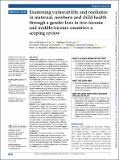Files in this item
Examining vulnerability and resilience in maternal, newborn and child health through a gender lens in low-income and middle-income countries : a scoping review
Item metadata
| dc.contributor.author | Sule, Fatima Abdulaziz | |
| dc.contributor.author | Uthman, Olalekan A | |
| dc.contributor.author | Olamijuwon, Emmanuel Olawale | |
| dc.contributor.author | Ichegbo, Nchelem Kokomma | |
| dc.contributor.author | Mgbachi, Ifeanyi C | |
| dc.contributor.author | Okusanya, Babasola | |
| dc.contributor.author | Makinde, Olusesan Ayodeji | |
| dc.date.accessioned | 2022-04-21T12:30:13Z | |
| dc.date.available | 2022-04-21T12:30:13Z | |
| dc.date.issued | 2022-04-20 | |
| dc.identifier | 279177322 | |
| dc.identifier | 34eae7e6-ba38-4945-9611-1fb9b4f8e661 | |
| dc.identifier | 85130924028 | |
| dc.identifier.citation | Sule , F A , Uthman , O A , Olamijuwon , E O , Ichegbo , N K , Mgbachi , I C , Okusanya , B & Makinde , O A 2022 , ' Examining vulnerability and resilience in maternal, newborn and child health through a gender lens in low-income and middle-income countries : a scoping review ' , BMJ Global Health , vol. 7 , no. 4 , e007426 . https://doi.org/10.1136/bmjgh-2021-007426 | en |
| dc.identifier.issn | 2059-7908 | |
| dc.identifier.other | crossref: 10.1136/bmjgh-2021-007426 | |
| dc.identifier.other | ORCID: /0000-0002-6109-8131/work/111976041 | |
| dc.identifier.uri | https://hdl.handle.net/10023/25223 | |
| dc.description | Funding This work was supported by the Bill & Melinda Gates Foundation under investment INV-015806 awarded to the Viable Helpers Development Organisation. | en |
| dc.description.abstract | Introduction Gender lens application is pertinent in addressing inequities that underlie morbidity and mortality in vulnerable populations, including mothers and children. While gender inequities may result in greater vulnerabilities for mothers and children, synthesising evidence on the constraints and opportunities is a step in accelerating reduction in poor outcomes and building resilience in individuals and across communities and health systems. Methods We conducted a scoping review that examined vulnerability and resilience in maternal, newborn and child health (MNCH) through a gender lens to characterise gender roles, relationships and differences in maternal and child health. We conducted a comprehensive search of peer-reviewed and grey literature in popular scholarly databases, including PubMed, ScienceDirect, EBSCOhost and Google Scholar. We identified and analysed 17 published studies that met the inclusion criteria for key gendered themes in maternal and child health vulnerability and resilience in low-income and middle-income countries. Results Six key gendered dimensions of vulnerability and resilience emerged from our analysis: (1) restricted maternal access to financial and economic resources; (2) limited economic contribution of women as a result of motherhood; (3) social norms, ideologies, beliefs and perceptions inhibiting women’s access to maternal healthcare services; (4) restricted maternal agency and contribution to reproductive decisions; (5) power dynamics and experience of intimate partner violence contributing to adverse health for women, children and their families; (6) partner emotional or affective support being crucial for maternal health and well-being prenatal and postnatal. Conclusion This review highlights six domains that merit attention in addressing maternal and child health vulnerabilities. Recognising and understanding the gendered dynamics of vulnerability and resilience can help develop meaningful strategies that will guide the design and implementation of MNCH programmes in low-income and middle-income countries. | |
| dc.format.extent | 11 | |
| dc.format.extent | 1244650 | |
| dc.language.iso | eng | |
| dc.relation.ispartof | BMJ Global Health | en |
| dc.subject | RG Gynecology and obstetrics | en |
| dc.subject | 3rd-DAS | en |
| dc.subject | SDG 1 - No Poverty | en |
| dc.subject | SDG 3 - Good Health and Well-being | en |
| dc.subject | SDG 16 - Peace, Justice and Strong Institutions | en |
| dc.subject | MCC | en |
| dc.subject.lcc | RG | en |
| dc.title | Examining vulnerability and resilience in maternal, newborn and child health through a gender lens in low-income and middle-income countries : a scoping review | en |
| dc.type | Journal article | en |
| dc.contributor.institution | University of St Andrews. School of Geography & Sustainable Development | en |
| dc.identifier.doi | https://doi.org/10.1136/bmjgh-2021-007426 | |
| dc.description.status | Peer reviewed | en |
This item appears in the following Collection(s)
Items in the St Andrews Research Repository are protected by copyright, with all rights reserved, unless otherwise indicated.

